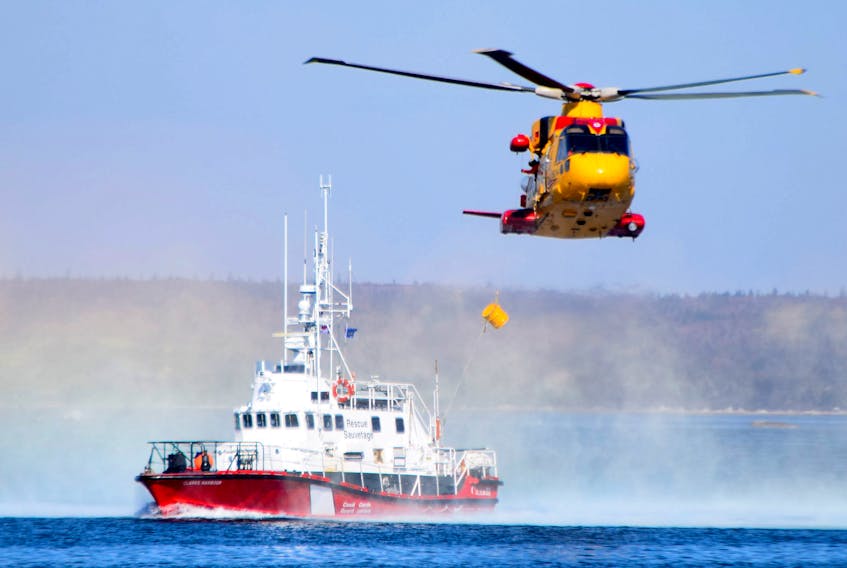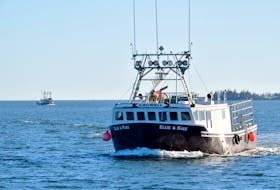SOUTHWESTERN NS – Inshore and offshore Search and Rescue (SAR) platforms will already be on the fishing grounds and in position when lobster fishermen in LFAs 33 and 34 head out to set their traps on dumping day.
A total of 12 dedicated SAR platforms along with two DFO patrol vessels that are SAR ‘go-to’ resources will be deployed in advance of the fleet leaving ports at 6 a.m. in LFA 34 and 7 a.m. in LFA 33, says Sean Arbour, Maritime Search and Rescue coordinator for the Joint Rescue Coordination Centre.
Starting with the three Canadian Coast Guard lifeboat stations along the coast – Sambro, Clark’s Harbour and West Port – the cutters will be deployed in advance of the shotgun start, with a second crew on standby at the life station base with a Fast Response Craft (FRC).
“We will be double crewing all the life stations along the shore,” Arbour says.

Offshore, the Canadian Coast Guard will station two large vessel platforms – one about 12 miles off Port Mouton and the other about 50 miles southwest of Yarmouth. Arbour says the Earl Grey and Edward Cornwallis will likely be the offshore vessels deployed.
“We want to have a large platform capability if the weather is bad or gets really bad or a large-scale event happens,” he says.
“The Canadian Coast Guard Auxiliary is going to be playing a large part in the assets as they did last year,” says Arbour. Three vessels will be stationed on the fishing grounds off Port Mouton, Shelburne and Yarmouth counties.
“The Coast Guard Auxiliary helping definitely makes a huge difference,” says Arbour.
Also on the water will be three conservation and protection vessels in and around the area. Two of the vessels are primarily going to be doing fisheries patrols but will be a go-to SAR platform, if needed, says Arbour. The third vessel will be a dedicated SAR platform. Those vessels will patrol where there is the highest density of marine traffic, likely off Shelburne County.
As for air assets, Arbour says a Cormorant helicopter will be deployed from Greenwood and placed on stand-by at the Yarmouth airport for dumping day, which, weather permitting, takes place on the last Monday of November.
“They are that much closer if any kind of response is needed,” says Arbour, adding the chopper can be airborne within 10 minutes. With the crew already in Yarmouth, he says, “They should be on scene in the area of responsibility within 20 to 25 minutes.”
Arbour says there is some consideration being given to having a second Cormorant on stand-by in Greenwood.
“In previous years we have had only one available but this year we may have two,” he says. “We haven’t had the scenario yet where we need two Cormorants but it’s always good to have that.”
Also in the air dumping day will be a Hercules fixed wing military aircraft that will be on patrol between Halifax and Digby following the shoreline.
“They will be maintaining that patrol all day until the majority of fishing activity begins to slow down,” explains Arbour. “It’s typically eight to 10 hours of patrol.”
As always, Mother Nature dictates when it comes to dumping day. Any winds over 26 knots and the start will be delayed until better weather prevails.
“Fishermen realize dumping day doesn’t go so well if you push the weather,” says Arbour. “Weather has been less of a risk factor the last few years because they don’t push it so that’s been great.”
BE AWARE
With almost 1,700 fishing vessels laden with lobster pots taking to the ocean at basically the same time on dumping day, Arbour advises fishermen to have “situational awareness;” know who’s around them, who might get into trouble and keep a listen on channel 16.
“Regardless of what happens, 14 SAR and patrol vessels on the water is quite a bit, but when there are 1,700 vessels going out for the fishing season a lot can happen at any given time,” he says. “And so we count on them helping themselves or helping those around them in an emergency situation.”
Arbour notes it is often another fishing vessel that can get to the scene first.









